Selecting a garage door is a significant decision that goes beyond just budget, as they are a major investment. With numerous types and price ranges, it can be overwhelming to choose the right one.
Fortunately, we’re here to guide you through this important choice!
Key Factors in Choosing Garage Doors
When selecting garage doors, consider these key factors:
- Budget: Determine how much you can afford, balancing it with other factors.
- Security: Assess the level of protection the doors offer against potential intruders.
- Maintenance: Evaluate how much effort is needed to keep the doors in good condition.
- Insulation: Decide if the doors need to prevent heat loss, especially if you use the garage as a utility room.
- Color: Choose from available colours, which depend on the door type and material.
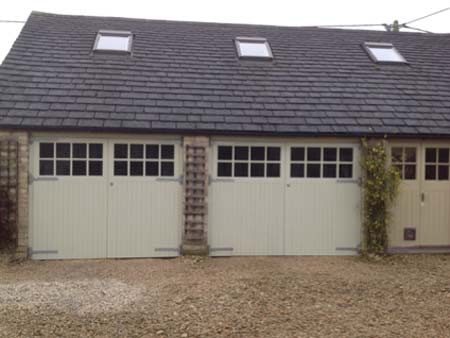
The right garage doors can greatly enhance your home’s appearance. Image courtesy of Dancing Beanz.
Consider these factors in relation to the size of your garage opening and the space needed for different door mechanisms. If building a new garage, plan for door selection early to avoid constraints later.
Matching your garage door to your front door may limit your options, as there are fewer matching choices available.
Additionally, space constraints inside and outside the garage will impact your choice of door mechanism. For example, limited driveway space can restrict your options for swinging doors.
In summary, the main constraints include:
- The size of the garage opening
- Matching with your front door
- Any planning or property restrictions*
- Available space for door operation
*Planning permission is generally not required for garage doors, but restrictions may apply if you live in a listed building or conservation area. Check with your property management or landlord if applicable.
Choosing Materials for Garage Doors
Garage doors come in four main materials:
- Steel
- Aluminium
- Timber
- Glass Reinforced Polyester (GRP) or glass fibre
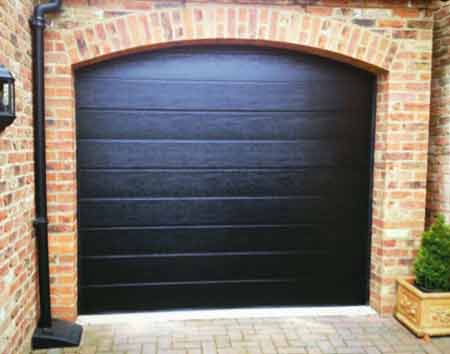
Choosing the right material for your garage doors can significantly impact your home’s look. Image courtesy of Fenland Garage Doors.
The style of your home should guide your choice. Contemporary homes often pair well with modern materials, while traditional homes may benefit from classic styles. Ultimately, your personal preference is what matters at the end of the day.
Steel doors are lightweight and easy to handle. They come primed for you to add your preferred finish. For painting tips, see our guide on painting metal garage doors.
Aluminium doors are ideal for garages under living spaces due to their noise-reducing qualities.
Timber/GRP doors were once popular but have been largely replaced by GRP doors. GRP doors are strong, resistant to damage and rot, and require minimal maintenance.
For tips on maintaining timber doors, visit our guide on painting wooden garage doors.
GRP doors also come in wood-effect finishes, offering the aesthetic of wood with the durability and low maintenance of GRP.
Garage Door Sizes
Today, custom-sized garage doors are readily available from most major manufacturers, though they may come with higher costs and longer lead times compared to standard sizes.
If you’re replacing an existing garage door, you’ll need to match it to your current opening size. Fortunately, there is a broad range of standard sizes that fit most typical garage openings.
It’s a good idea to compare sizes from different manufacturers, as there can be variations. A reliable garage door installation company can help you navigate your options. Find a trusted installer in your area here.
Here are some popular standard sizes for various types of garage doors:
Steel and Aluminium Garage Door Sizes
- Width: 1981 mm to 4267 mm (6 feet 6 inches to 14 feet)
- Height: 1981 mm to 2134 mm (6 feet 6 inches to 7 feet)
GRP Garage Door Sizes
- Width: 2134 mm to 4267 mm (7 feet to 14 feet)
- Height: 1981 mm to 2134 mm (6 feet 6 inches to 7 feet)
Timber Garage Door Sizes
Due to the nature of timber, sizes formats do differ slightly depending on the type of door. With this in mind, it’s best to contact a given manufacturer as they are likely to produce doors to your size specifications.
Standard GRP door sizes typically cover most needs, so custom doors are usually only necessary for non-standard openings. Custom doors can be more expensive, so sticking to standard sizes can save you money.
Garage Door Opening Mechanisms
When selecting garage doors, the opening mechanism is crucial. It affects how easily the door operates and how well it suits your garage’s uses beyond just parking your car.
Here are the main types of garage door mechanisms, each with its own advantages and disadvantages:
- Up-and-over garage doors
- Sectional garage doors
- Roller garage doors
- Side-hinged garage doors
- Round-the-Corner or Side-sliding garage doors
We’ll explore these options in detail below:
Up-and-Over Garage Doors
Up-and-over garage doors open by swinging up and over the garage entrance. They are widely used and available in various sizes, colors, and materials. These doors can be operated manually or electronically. There are two main types:
- Canopy Doors: Partially retract into the garage, leaving a horizontal canopy that extends beyond the garage entrance.
- Retractable Doors: Fully retract into the garage without leaving a canopy, offering a quieter and stronger operation compared to canopy doors.
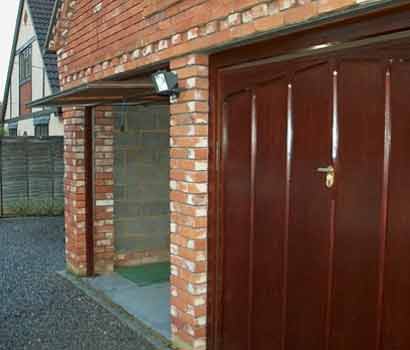
Canopy Garage Door – Image courtesy of HomePosh
Up-and-over doors are affordable, durable, and weatherproof, with many style and colour options available. However, they require space to open outward, so they are not ideal if you have limited driveway space or park close to the door.
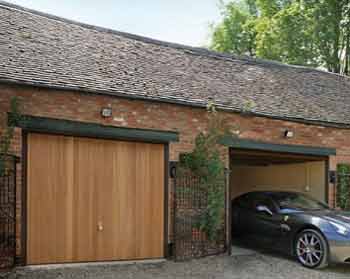
A Retractable Garage Door – Image courtesy of Lime BDS
Sectional Garage Doors
Sectional garage doors consist of multiple panels that slide up and back into the garage on rails, avoiding the need to swing out over the driveway.
Though they have a more complex mechanism and typically require electrical operation, which can increase both cost and installation time, they offer several benefits in that they save driveway space, are strong and secure, easily insulated, and ideal for large openings.
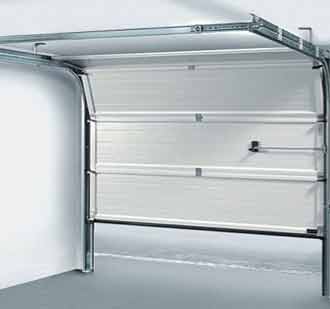
Sectional Garage Doors – Image courtesy of Garage Doors Online
Roller Garage Doors
Roller garage doors operate on tracks along the garage walls and are typically controlled by an electric remote. Unlike sectional doors, roller doors roll up into a compact coil above the door opening, rather than sliding back into the ceiling space.
This vertical opening mechanism saves driveway space and keeps the garage ceiling free for storage and lighting. Roller doors are strong, secure, and can be insulated, offering similar benefits to sectional doors. Installation is straightforward and daily use is easy.
However, due to their design, they may not suit every property and are generally quite a bit more expensive.
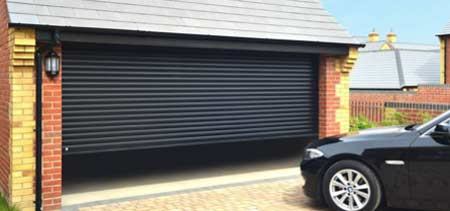
Roller Garage Doors – Image courtesy of Cheshire Garage Doors
Side-Hinged Garage Doors
Side-hinged garage doors, also known as “coach house door”, open like traditional doors on hinges at the side. Typically, they consist of two outward-opening panels. These doors complement both traditional and contemporary homes.
They are convenient for frequent foot traffic, easy to open, and occupy minimal space inside the garage, making them ideal for garages with limited storage.
Side-hinged doors are low maintenance, easy to install, and can be made secure and well-insulated. However, they require space to open fully, so again, they’re not suitable for driveways with limited space. While automation is possible, other door types may be better suited for automation.

Hinge Sided Garage Door – Image courtesy of Dimension Garage Doors
Round-the-Corner or Side-Sliding Garage Doors
Round-the-corner or side-sliding garage doors operate similarly to sectional or roller doors but slide horizontally rather than vertically. They use a floor track and an overhead rail to guide the panels as they open.
This design is ideal for very wide garage openings and allows partial access without fully opening the door, making it convenient for quick pedestrian access. It also saves driveway space since the door doesn’t extend outward when opening.
However, side-sliding doors require space along the garage wall for storage and are generally more expensive. Additionally, the choice of material can affect the style and frame requirements:
- Steel, aluminium, or GRP doors need steel frames.
- Softwood doors require timber frames.
- Roller doors operate with floor tracks and overhead guide rails, eliminating the need for traditional frames.
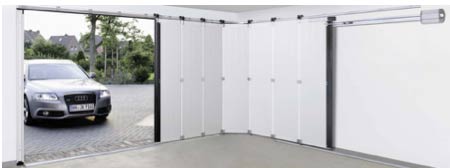
A round the corner sliding garage door – Image courtesy of Access Garage Doors
Garage Door Opening Options
Garage doors can be opened either manually or with a remote control, depending on the door style and mechanism.
There are two main types of automatic door openers:
- Remote Control: Operates by pointing a remote at a sensor inside the garage to open the door.
- Entry Pad: Mounted outside the garage, this requires a four-digit code to open the door. It’s less popular due to the inconvenience of getting out of the car to enter the code, especially in bad weather.
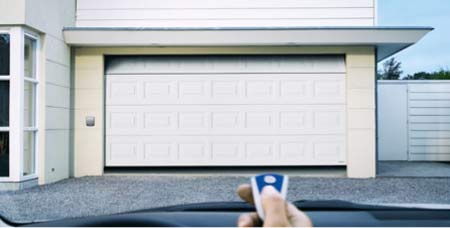
Automatic opening and closing garage doors make life much easier – Image courtesy of CDC Garage Doors
Estimated Costs for Garage Doors
Garage doors typically range in cost a great deal, depending on the type, style, material etc. door you go for. Typical costs range from £400 to £4,000, including VAT and delivery.
Standard single garage doors can often be installed by DIYers, while double garage doors usually require professional installation, especially if an electric opener is involved. Find a local installer here.
Installation costs start around £300 and vary based on door type and garage specifics.
Adding an automatic opener will generally cost an extra £200 or more. However, this upgrade can usually be added later to most doors if required.
For the best results, select your garage doors early and thoroughly research your options.
We hope that this guide provides key tips to help you choose the right garage doors. We recommend comparing options to ensure you make an informed decision. Investing in a quality garage door is important and if maintained correctly, they’ll last for many years to come.

